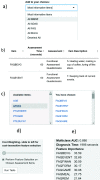Alzheimer's Disease Assessments Optimized for Diagnostic Accuracy and Administration Time
- PMID: 35557505
- PMCID: PMC9089816
- DOI: 10.1109/JTEHM.2022.3164806
Alzheimer's Disease Assessments Optimized for Diagnostic Accuracy and Administration Time
Abstract
Objective: Despite the potential of machine learning techniques to improve dementia diagnostic processes, research outcomes are often not readily translated to or adopted in clinical practice. Importantly, the time taken to administer diagnostic assessment has yet to be taken into account in feature-selection based optimisation for dementia diagnosis. We address these issues by considering the impact of assessment time as a practical constraint for feature selection of cognitive and functional assessments in Alzheimer's disease diagnosis.
Methods: We use three different feature selection algorithms to select informative subsets of dementia assessment items from a large open-source dementia dataset. We use cost-sensitive feature selection to optimise our feature selection results for assessment time as well as diagnostic accuracy. To encourage clinical adoption and further evaluation of our proposed accuracy-vs-cost optimisation algorithms, we also implement a sandbox-like toolbox with graphical user interface to evaluate user-chosen subsets of assessment items.
Results: We find that there are subsets of accuracy-cost optimised assessment items that can perform better in terms of diagnostic accuracy and/or total assessment time than most other standard assessments.
Discussion: Overall, our analysis and accompanying sandbox tool can facilitate clinical users and other stakeholders to apply their own domain knowledge to analyse and decide which dementia diagnostic assessment items are useful, and aid the redesigning of dementia diagnostic assessments. Clinical Impact (Clinical Research): By optimising diagnostic accuracy and assessment time, we redesign predictive and efficient dementia diagnostic assessments and develop a sandbox interface to facilitate evaluation and testing by clinicians and non-specialists.
Keywords: Cost-sensitive feature selection; assessment speed-accuracy trade-off; cognitive and functional assessments; dementia and Alzheimer’s disease diagnosis; sandbox GUI application.
Figures






References
-
- Folstein M. F., Folstein S. E., and McHugh P. R., “Mini-mental state: A practical method for grading the cognitive state of patients for the clinician,” J. Psychiatric Res., vol. 12, no. 3, pp. 189–198, Nov. 1975. - PubMed
Publication types
MeSH terms
Grants and funding
LinkOut - more resources
Full Text Sources
Medical

